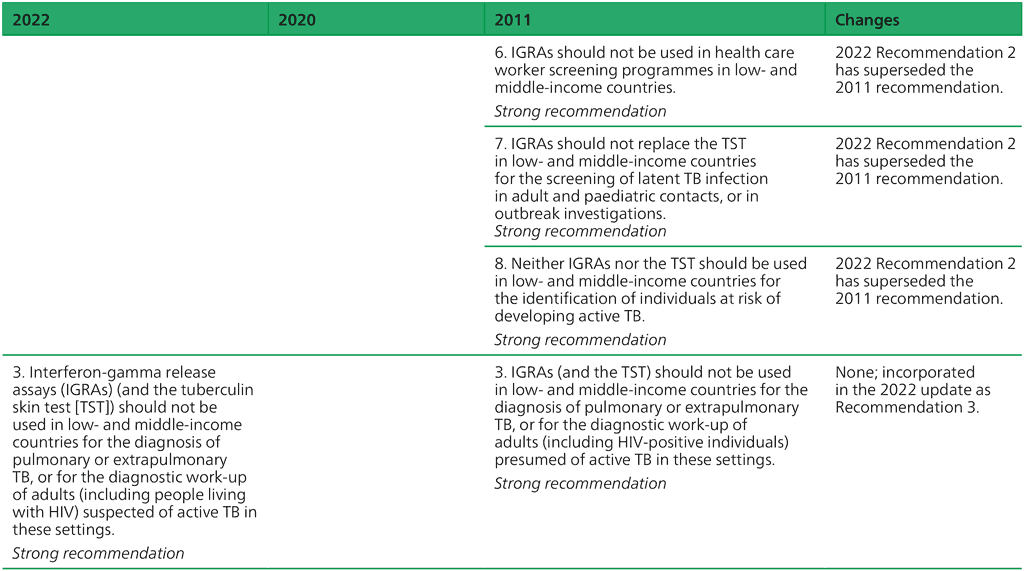Consolidated Guidelines
References
- Public announcement to TB in vitro diagnostics manufacturers, procurement agencies and national TB programmes on inclusion of WHO prequalification for TB in vitro diagnostics. Geneva: World Health Organization; 2021 (https://extranet.who.int/pqweb/sites/default/files/documents/210211_ PublicAnnouncement_TB_%20in-vitro-diagnostics.pdf).
- Schünemann HJ, Mustafa RA, Brozek J, Steingart KR, Leeflang M, Murad MH et al. GRADE guidelines: 21 part 2.
3.4.6. Operational aspects of the use of IGRAs
Operational aspects of the use of IGRAs were as follows:
3.4.5. Use of IGRAs in the diagnosis of active TB
Studies included were those that evaluated the performance of the technologies of interest for the diagnosis of TB disease among adult (>15 years) with presumed TB or people with TB in LMIC.
3.4.4. Data synthesis and meta-analysis
A standardized overall approach was specified a priori for each systematic review, to account for significant heterogeneity in results expected between studies. First, data were synthesized separately for each commercial IGRA and by the World Bank country income classification (LMIC versus high-income countries) as a surrogate for TB incidence. Second, heterogeneity was visually assessed using forest plots, and the variation in study results attributable to heterogeneity was characterized (I-squared statistic) and statistically tested (chi-squared test).
3.4.3. Studies search, selection and quality assessment
All studies evaluating IGRAs published up to the end of May 2010 were reviewed using predefined data search strings. In addition to database searches, bibliographies of reviews and guidelines were reviewed, citations of all included studies were screened, and experts in the field as well as IGRA manufacturers were contacted to identify additional studies (published, unpublished and ongoing). Pertinent information not reported in the original publications was requested from the primary authors of all studies included by the systematic reviewers.
3.4.2. Hierarchy of reference standards
Studies evaluating the performance of IGRAs are hampered by the lack of a gold standard to distinguish the presence or absence of TB infection. Since diagnostic accuracy for TB infection could not be directly assessed, a hierarchy of reference standards was developed and agreed beforehand with the systematic reviewers, to evaluate the role of IGRAs, depending on the individual topic (i.e. not all systematic reviews necessarily used the hierarchy).
3.4.1. PICO questions
What is the diagnostic accuracy of commercial IGRAs for pulmonary TB in adult pulmonary TB suspects and confirmed TB cases in LMIC as compared with microbiological (culture or smear-microscopy) or clinical diagnosis of pulmonary TB?
3.5. Research priorities
Targeted further research to identify IGRAs with improved accuracy is strongly encouraged. Such research should be based on adequate study design, including quality principles such as representative suspect populations, prospective follow-up, and adequate and explicit blinding. It is also strongly recommended that proof-of-principle studies be followed by evidence produced from prospectively implemented and well-designed evaluation and demonstration studies, including assessment of patient impact.
3.4. Evidence base
A systematic, structured, evidence-based process for TB diagnostic policy generation was followed. The first step constituted systematic reviews and meta-analysis of available data (published and unpublished), using standard methods appropriate for diagnostic accuracy studies. The second step involved the convening of a GDG to evaluate the strength of the evidence base, evaluate the risks and benefits of using IGRAs in LMIC and identify gaps to be addressed in future research.
Pagination
- Previous page
- Page 24
- Next page
 Feedback
Feedback
